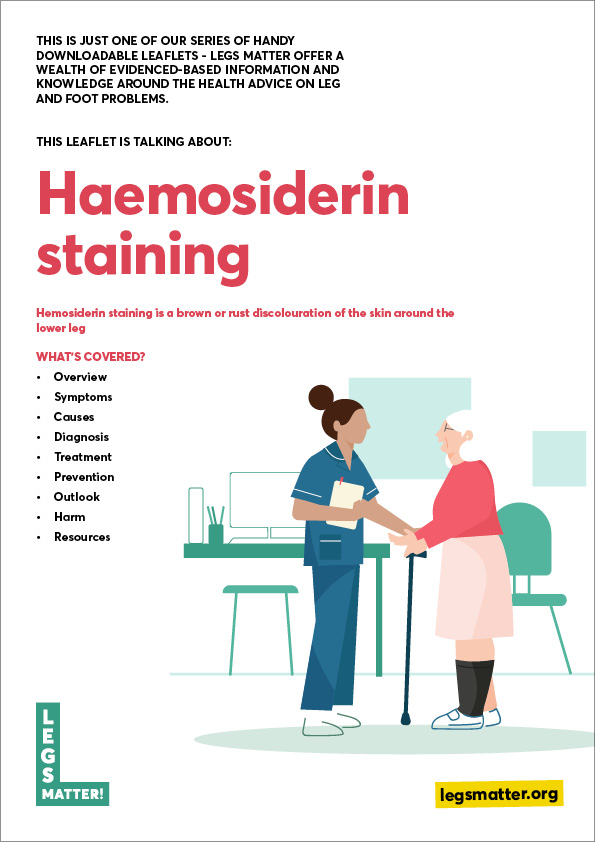Overview – reddish / darker skin staining above the ankle
Changes to your normal skin tone on the lower legs, normally above the ankles, which may present as darker skin staining (haemosiderin). This is likely to be caused by venous hypertension.
Symptoms – what is haemosiderin staining?
Haemosiderin staining, also known as venous staining occurs when red blood cells leak through the smallest blood vessels (capillaries) and are forced into the tissues. As they are broken down, iron released from the haemoglobin is converted into a substance called haemosiderin and stored in the tissue beneath the skin.
This will then change how your skin looks, often appearing as brown or purple staining, depending upon your skin tone.
Consider and observe
Does your occupation involve you having to stand for long periods, are you tall or do you have a family history of varicose veins or leg ulcers. Do you have heavy aching legs after a long day’s work or notice swelling that is increasing or skin changes which may include darker brown or reddish staining and dry itchy skin patches. Seek advice from your local pharmacy, practice nurse or GP as this could be the early signs of venous hypertension or insufficiency in the leg veins.
Causes – what causes hemosiderin staining?
Venous hypertension / insufficiency
Venous hypertension / insufficiency happens when high pressure in the veins in your legs causes substances from the blood to leak into your tissues. Blood is pumped from the heart to the rest of the body through the arteries and returns through the veins. The blood is propelled back to the heart by your heart pumping and actions of your calf and foot muscles during walking and ankle movement.
Your veins contain one-way valves to stop your blood falling back towards your toes. These valves can become weak or damaged. When this happens, your veins become so swollen (varicose veins) that blood leaks into the tissue of your skin.
The haemoglobin from red blood cells is released into your skin tissue and degrades or breaks down into haemosiderin. It is this haemosiderin that causes darker brown or reddish patches of skin above your ankle. The stained skin is very fragile and may break down or, if knocked, fail to heal as usual. What you will experience will depend on your skin tone. If you have a dark skin tone then your skin will have darker patches but may not have a reddish colour. Light skin tones may start with reddish patches. Regardless of your skin tone, the skin itself may be itchy or harder to the touch.
Diagnosis – getting diagnosed with haemosiderin staining
If your legs have reddish or brown stains on them, this may be an indication of venous insufficiency, therefore you should make an appointment at your GP practice to see a healthcare practitioner, this may be a doctor or a nurse.
Alternatively, there might be a Leg Club or specialist leg clinic in your area – you should be able to get information on how to access this service from your doctors surgery.
Remember to remove any nail polish from your toenails before your appointment.
When you see the nurse or doctor, they should:
- Ask about your symptoms and how long you have had problems
- Review your past medical history and medications, social history
- Examine your lower legs
You may be offered a simple test called a Doppler ultrasound. This test measures the blood pressure in your ankle and compares it to the pressure in your arm to see if you have problems with the arterial blood supply to your lower leg. You might have to come back to have your Doppler test on a different day or at another clinic but you should have this test within a few weeks of your first appointment.
You might also be offered further tests to check for other health problems that can affect your legs such as diabetes and anaemia.
If your GP or nurse thinks you have problems with your veins or arteries, they might refer you for further vascular tests at your local hospital or specialist clinic.
When you see the nurse or doctor ensure they take your height and weight and calculate your BMI (Body Mass Index). Being overweight can predispose you to problems in the legs such as swelling, varicose veins and skin changes.
Treatment – what treatment will I be offered for hemosiderin staining?
Moisturising your skin
It is important to keep your skin clean and well moisturised. Avoid soap as this can be very drying. Instead, use a moisturising soap substitute when washing, bathing and showering.
When washing ensure the water is not too hot as this can dry the skin and cause irritation. After washing gently dry the skin avoiding excessive rubbing to reduce friction and irritation. Ensure the skin is fully dry before applying a moisturiser paying particular attention to in between the toes. Applying the moisturiser in the direction of hair growth (normally downwards), this can help prevent irritation of the hair follicle from the moisturiser.
Always moisturise your skin after washing, bathing and showering. You might want to use a bath emollient or oil as well as a moisturising lotion, cream or ointment, as these clean and hydrate the whole body. If you’re using bath oils, remember to also use a rubber mat or grip rail as the bathtub can become very slippery. Emollients can be obtained via prescription or over the counter. Please ensure you follow recommended guidance on the produce you are using.
Compression therapy
Following assessment, if safe and appropriate, you should be offered compression therapy. Compression therapy improves blood flow through the veins by applying supportive pressure to the leg and tissues. This may be delivered in a number of different ways, such as bandaging the limb or by wearing supportive socks, stockings, tights or wraps, depending on clinical need and patient choice. Compression therapy is very effective at reducing swelling and healing or preventing sores or ulcers.
Compression can be a little uncomfortable when you first start treatment, but any discomfort should reduce as the swelling goes down. You might find it helpful to take pain killers when you start compression therapy or speak to your health care professional for further advice.
Outlook – what’s the outlook for haemosiderin staining?
Compression therapy reduces inflammation and thus wearing this will prevent further skin staining and soften any hardened areas. However, any staining present is unlikely to fully resolve, but may lighten and be less noticeable.
Prevention – how can you prevent haemosiderin staining?
Exercise, diet and skin care
Try and take regular exercise, such as a brisk 30 minute walk, at least three times a week. This is because exercising your foot and calf muscles will reduce the venous hypertension and skin staining.
You could also try this gentle exercise while sitting down: move your feet around in circles, then up and down. This helps get blood back to your heart.
Speak to your nurse and / or doctor about ways to support your exercise and diet regime as this is an important part of keeping legs and feet healthy. You can also access support from your local pharmacy.
Continued skin care and compression is essential, even if you see an improvement in your symptoms.
Where’s the harm?
Inaction or insufficient action on venous leg ulcers can cause harm. This includes:
- Not checking legs properly or doing basic checks, such as a Doppler test
- Not performing a vascular assessment to determine if suitable for compression
- Not using adequate compression if indicated, can lead to worsening disease
- Not being referred to vascular services for venous intervention if required
- Ignoring the changes which simply increases your risk of having leg ulcers
If you have any concerns about the treatment or care you are receiving, it is important to speak up.
Resources
National Wound Care Strategy Programme – Why compression is important for the treatment and prevention of venous leg ulcers (PDF)
Venous Leg Ulcers (Legs Matter web page)
Holistic management of venous leg ulceration (second edition) (Download a PDF from the Wounds UK website)
Haemosiderin staining downloadable leaflet (PDF)
We’ve created a handy downloadable leaflet of the key information on this page so you can easily print it out for personal reference or to hand to a patient or healthcare professional. Or you can also simply forward it on by email.
Other support
Accelerate Based in East London, Accelerate can accept national referrals from your GP / specialist to our world-class centre where we pioneer and trial experimental new treatments for chronic leg ulcers / wounds, lymphoedema and mobility challenges.
Contact details
020 3819 6022
hello@acceleratecic.com
Find out more on the Accelerate website
The Lindsay Leg Club Foundation Promoting and supporting community based treatment, health promotion, education and ongoing care for people who are experiencing leg-related problems - including leg ulcers and other wound care issues.
Contact details
01473 749565
lynn.bullock@legclubfoundation.com
Find out more on the Lindsay Leg Club Foundation website
NHS Choices the official NHS website, which provides vital information and support about leg and foot signs and other symptoms.
Contact details
Call 111 - for non-emergency medical advice
Find out more on the NHS Choices website
Tell us what you think
If there’s anything you want to ask us or tell us, whether it’s a suggestion about our website, a complaint, or a compliment, drop us a line at
support@legsmatter.org










